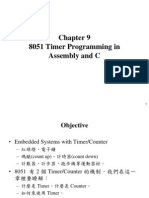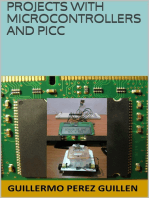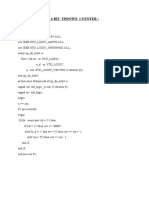REPORTLAB3 Ee271
REPORTLAB3 Ee271
Uploaded by
Như TríCopyright:
Available Formats
REPORTLAB3 Ee271
REPORTLAB3 Ee271
Uploaded by
Như TríOriginal Description:
Original Title
Copyright
Available Formats
Share this document
Did you find this document useful?
Is this content inappropriate?
Copyright:
Available Formats
REPORTLAB3 Ee271
REPORTLAB3 Ee271
Uploaded by
Như TríCopyright:
Available Formats
1
Extra Lab - Student Shop Group 10 : Nguyn nh Minh Nht-Trng Minh Quc-Ng Nh Tr
REPORT EXTRA LAB EE 271
GROUP 10 Nguyn nh Minh Nht Trng Minh Quc Ng Nh Tr
Extra Lab - Student Shop Group 10 : Nguyn nh Minh Nht-Trng Minh Quc-Ng Nh Tr
OUTLINE
I. LAB REQUIREMENTS AND THE SOLUTION II. SYSTEM DESIGN III. CODE AND SIMULATION IV. CONCLUSIONS
Extra Lab - Student Shop Group 10 : Nguyn nh Minh Nht-Trng Minh Quc-Ng Nh Tr
I.
LAB REQUIREMENTS AND THE SOLUTION
In this laboratory, we are required to design a system that displays the code of the items in the 7 segments decoders as well as displays on sale? and expensive? states of yes or no of th ese items in both 7 segments decoders and Red LEDs. The input of this systems is controlled by 3 switches, whose on, off states demonstrates the binary UPC code of items. The on sale LEDR*1+ and expensive LEDR*0+ display as same as the on sale and expensive 7 segments decoders, respectively.
Extra Lab - Student Shop Group 10 : Nguyn nh Minh Nht-Trng Minh Quc-Ng Nh Tr
The outputs display has to follow the table:
Extra Lab - Student Shop Group 10 : Nguyn nh Minh Nht-Trng Minh Quc-Ng Nh Tr
SOLUTION FOR THE LAB REQUIREMENTS
For this problem, we suggest that the item should be solved independently, one after another, that is for each case of input items, we write the code for 7 segments decoders to display the item codes ( for 7 segments decoders no.1 and no.2) and on sale?, expensive? states ( for 7 segments decoders no.3 and no.4). If the input UPC code is not found in the above table, system would display nothing. For example, if the input is 001, that is Spring Shoes, the code is as follow: case (x) 3'b001: begin // 2 first 7 segments decoders display item code LedOut1 = 7'b0001000; // display letter A LedOut2 = 7'b1001111; // display number 1 // 3rd 7 segments decoders display yes no state of on sale? LedOut3 = 7'b1111111; // display nothing meaning no // 4th 7 segments decoders display yes no state of expensive? LedOut4 = 7'b0000000; // display 8 meaning yes // 2 red LED display as the same as 7 segments decoders 3rd and 4th, respectively LEDR[0] = 0; LEDR[1] = 1; end
We have the table ruling the outputs display: x ( input ) LedOut1 (code letter) 1111111 0001000 1111111 0000000 0110001 0001000 0111000 0110001 LedOut2 LedOut3 (code number) (on sale? state) 1111111 1111111 1001111 1111111 1111111 1111111 0000110 1111111 0100100 0000000 0000100 1111111 0010010 0000000 0000000 0000000 LedOut4 (expensive? state 1111111 0000000 1111111 1111111 1111111 0000000 0000000 1111111 LEDR[0] LEDR[1]
000 001 010 011 100 101 110 111
0 1 0 0 0 1 1 0
0 0 0 0 1 0 1 1
Extra Lab - Student Shop Group 10 : Nguyn nh Minh Nht-Trng Minh Quc-Ng Nh Tr
II.
SYSTEM DESIGN
LedOut1 (7 bits) LedOut2 (7 bits) x (3 bit) STUDENT SHOP LedOut2 (7 bits) LedOut2 (7 bits) LEDR (2 bits)
Extra Lab - Student Shop Group 10 : Nguyn nh Minh Nht-Trng Minh Quc-Ng Nh Tr
III.
CODE AND SIMULATION
VERILOG CODE
module StudentShop(LedOut1, LedOut2, LedOut3, LedOut4, LEDR, x); output reg [0:6] LedOut1; output reg [0:6] LedOut2; output reg [0:6] LedOut3; output reg [0:6] LedOut4; output reg [0:1] LEDR; input [0:2] x; always @(x) case (x) 3'b001: begin LedOut1 LedOut2 LedOut3 LedOut4 LEDR[1] LEDR[0] end 3'b011: begin LedOut1 = 7'b0000000; LedOut2 = 7'b0000110; LedOut3 = 7'b1111111; LedOut4 = 7'b1111111; LEDR[1]= 0; LEDR[0] = 0; end 3'b100: begin LedOut1 LedOut2 LedOut3 LedOut4 LEDR[1] LEDR[0] end 3'b101: begin LedOut1 LedOut2 LedOut3 LedOut4 LEDR[1] LEDR[0] end 3'b110: begin LedOut1 = 7'b0111000; LedOut2 = 7'b0010010; = = = = = = 7'b0001000; 7'b0000100; 7'b1111111; 7'b0000000; 0; 1; = = = = = = 7'b0110001; 7'b0100100; 7'b0000000; 7'b1111111; 1; 0; = = = = = = 7'b0001000; 7'b1001111; 7'b1111111; 7'b0000000; 0; 1;
Extra Lab - Student Shop Group 10 : Nguyn nh Minh Nht-Trng Minh Quc-Ng Nh Tr LedOut3 LedOut4 LEDR[1] LEDR[0] end 3'b111: begin LedOut1 LedOut2 LedOut3 LedOut4 LEDR[1] LEDR[0] end default: begin LedOut1 = LedOut2 = LedOut3 = LedOut4 = LEDR[1] = LEDR[0] = end endcase endmodule 7'b 7'b 7'b 7'b 0; 0; 1111111; 1111111; 1111111; 1111111; //1 //1 //1 //1 = = = = = = 7'b0110001; 7'b0000000; 7'b0000000; 7'b1111111; 1; 0; = = = = 7'b0000000; 7'b0000000; 1; 1;
Extra Lab - Student Shop Group 10 : Nguyn nh Minh Nht-Trng Minh Quc-Ng Nh Tr
TEST BENCH CODE
module studentshop_tb; wire [0:6] LedOut1_tb; wire [0:6] LedOut2_tb; wire [0:6] LedOut3_tb; wire [0:6] LedOut4_tb; wire LedR1_tb, LedR2_tb; reg [0:2] x_tb; StudentShop dut (LedOut1_tb, LedOut2_tb, LedOut3_tb, LedOut4_tb, LedR1_tb, LedR2_tb, x_tb); initial begin $dumpvars(1, dut); $dumpfile("studentshop_tb.vcd"); end initial begin x_tb = 3'b000; #25 x_tb = 3'b001; #25 x_tb = 3'b010; #25 x_tb = 3'b011; #25 x_tb = 3'b100; #25 x_tb = 3'b101; #25 x_tb = 3'b110; #25 x_tb = 3'b111; $finish; end endmodule
10
Extra Lab - Student Shop Group 10 : Nguyn nh Minh Nht-Trng Minh Quc-Ng Nh Tr
WAVEFORM:
11
Extra Lab - Student Shop Group 10 : Nguyn nh Minh Nht-Trng Minh Quc-Ng Nh Tr
COMMENTS:
The simulation is as we expect. For example, when the input is 011, the LedOut1 is 0000000 ( that is letter B ), the LedOut2 is 0000110 ( that is number 3 ), the LedOut3 is 1111111 ( nothing, means no ), the LedOut3 is 1111111(nothing, means no ), LEDR[0] and LEDR[1] are both 0.
The real result when we run the system in the FPGA KIT is the same as simulation.
12
Extra Lab - Student Shop Group 10 : Nguyn nh Minh Nht-Trng Minh Quc-Ng Nh Tr
IV.
CONCLUSIONS
You might also like
- 16 Bit AdderDocument4 pages16 Bit AdderNilesh Maurya100% (1)
- 4 Digits 7 Segment Display ENGDocument16 pages4 Digits 7 Segment Display ENGC R.No ratings yet
- Ee215 Lab ReportDocument16 pagesEe215 Lab ReportNguyễn Hữu BáchNo ratings yet
- Llab 3 Report Ece 331Document14 pagesLlab 3 Report Ece 331ToànNguyễnKhánh100% (1)
- VHDL KeypadDocument17 pagesVHDL Keypadtroid426No ratings yet
- 16 Bit CalculatorDocument17 pages16 Bit CalculatorPankaj JaiswalNo ratings yet
- 4 Bit Binary Adder (Mini-Calculator)Document9 pages4 Bit Binary Adder (Mini-Calculator)Amitabh Chandra AruniNo ratings yet
- Laboratory Report (For Online Lab Class Only) : ECTE333: Microcontroller Architecture and Application Spring 2020 SessionDocument8 pagesLaboratory Report (For Online Lab Class Only) : ECTE333: Microcontroller Architecture and Application Spring 2020 SessionSaad KamranNo ratings yet
- Project Report E-CampusDocument21 pagesProject Report E-CampusNikita Jain50% (4)
- Decoders Lab TaskDocument21 pagesDecoders Lab TaskAleena MuzahirNo ratings yet
- (EE332) (09ECE) (Group13) Report ProjectDocument23 pages(EE332) (09ECE) (Group13) Report ProjectNgô ĐạtNo ratings yet
- EE341 FinalDocument4 pagesEE341 FinalLe HuyNo ratings yet
- EE271 Lab1 Group06Document9 pagesEE271 Lab1 Group06Lê Vương TháiNo ratings yet
- Danang University of Science and Technology: Instructor: Nguyen Tri Bang Class: 15ECE2 Group Members: Vo Hoang ChuongDocument12 pagesDanang University of Science and Technology: Instructor: Nguyen Tri Bang Class: 15ECE2 Group Members: Vo Hoang ChuongBin BinNo ratings yet
- Dflipfop Easy Problem Marvin JavierDocument9 pagesDflipfop Easy Problem Marvin JavierAngelica FangonNo ratings yet
- Report Lab 1 CSE 461Document2 pagesReport Lab 1 CSE 461Nguyễn Văn ThiệnNo ratings yet
- Lab10 Dice GameDocument10 pagesLab10 Dice GamePhuc Van NguyenNo ratings yet
- Integrators, Differentiators, and Simple Filters: 6. PrelabDocument15 pagesIntegrators, Differentiators, and Simple Filters: 6. PrelabMIn LeNo ratings yet
- Ee215 Lab ReportDocument14 pagesEe215 Lab ReportNguyễn Hữu BáchNo ratings yet
- One Wire ProtocolDocument22 pagesOne Wire ProtocolPiPo Tui100% (1)
- Laboratory Exercise 2: Discrete-Time Systems: Time-Domain RepresentationDocument3 pagesLaboratory Exercise 2: Discrete-Time Systems: Time-Domain RepresentationbichchaukmtNo ratings yet
- Hamza Hanif DLD Lab #2Document7 pagesHamza Hanif DLD Lab #2Hamza KhanNo ratings yet
- HW Ông VinhDocument8 pagesHW Ông VinhQuốc Thắng NguyễnNo ratings yet
- DLCA - Practical NO 1Document23 pagesDLCA - Practical NO 104 Tushar BhadrikeNo ratings yet
- N (0:1:40) A 1.2 F 0.1 X A Cos (2 Pi F N) Stem (N, X,'r','filled') Xlabel ('TIME') Ylabel ('AMPLITUDE')Document7 pagesN (0:1:40) A 1.2 F 0.1 X A Cos (2 Pi F N) Stem (N, X,'r','filled') Xlabel ('TIME') Ylabel ('AMPLITUDE')shakaibNo ratings yet
- DE2 115 Pin AssignmentDocument4 pagesDE2 115 Pin AssignmentKamal HaydarNo ratings yet
- Lab Report Exp 1Document20 pagesLab Report Exp 1Elisbeth MurugasNo ratings yet
- 1.2 MARS Data Cache Simulator ToolDocument2 pages1.2 MARS Data Cache Simulator Toolamarsdd7238No ratings yet
- 8051 CH9 950217Document103 pages8051 CH9 950217Amardeep PotdarNo ratings yet
- TC 300 Uc InglesDocument62 pagesTC 300 Uc InglesTamo Activo MusicNo ratings yet
- CSC441 - CC - Lab Manual - V2.1 PDFDocument145 pagesCSC441 - CC - Lab Manual - V2.1 PDFbukhari sydaNo ratings yet
- Robot Technology: Ch.7 Trajectory Planning of RobotsDocument53 pagesRobot Technology: Ch.7 Trajectory Planning of RobotsmubarakNo ratings yet
- DFT/ FFT Using TMS320C5515 TM eZDSP USB Stick: Via CCS and MatlabDocument12 pagesDFT/ FFT Using TMS320C5515 TM eZDSP USB Stick: Via CCS and MatlabTrung Hoang PhanNo ratings yet
- (123doc) Xu Ly Tin Hieu So Bai3aDocument24 pages(123doc) Xu Ly Tin Hieu So Bai3aThành VỹNo ratings yet
- DSP Lab Sheet 2 PDFDocument50 pagesDSP Lab Sheet 2 PDFSreekrishna DasNo ratings yet
- Ecen 248 Lab 9 ReportDocument5 pagesEcen 248 Lab 9 Reportapi-241454978No ratings yet
- EE233 Lab1Document20 pagesEE233 Lab1NguyenThanhSang0404No ratings yet
- Calculating Real Power On An ArduinoDocument2 pagesCalculating Real Power On An ArduinoAndrej OrémušNo ratings yet
- DE2 SchematicDocument24 pagesDE2 Schematictqminh1990No ratings yet
- Test Bench For Shift RegisterDocument3 pagesTest Bench For Shift Registermnpaliwal02050% (4)
- Laplace Transform ExamplesDocument19 pagesLaplace Transform Exampleshamza abdo mohamoudNo ratings yet
- Địa Chỉ Các Bit Trong Các Thanh Ghi Của PIC16F877A PDFDocument4 pagesĐịa Chỉ Các Bit Trong Các Thanh Ghi Của PIC16F877A PDFDanh_IS4No ratings yet
- Assignment4 Solution 3rd EditionDocument7 pagesAssignment4 Solution 3rd Editionرغوووودي رغووووديNo ratings yet
- Design of Binary Multiplier Using Adders-3017 PDFDocument5 pagesDesign of Binary Multiplier Using Adders-3017 PDFAdrian Walter JavierNo ratings yet
- Practical File of Essentials of Information Technology (CSE-314N)Document16 pagesPractical File of Essentials of Information Technology (CSE-314N)Drishti GuptaNo ratings yet
- Frequency MeterDocument5 pagesFrequency Meterlaithnatour0% (1)
- ECEN 248 Lab8 - ReportDocument16 pagesECEN 248 Lab8 - ReportRebecca Sontheimer0% (1)
- Digital ElectronicsDocument102 pagesDigital Electronicsdurga0% (1)
- FRP C & DS DumpsDocument627 pagesFRP C & DS DumpsKiranraj DcNo ratings yet
- Digital ClockDocument11 pagesDigital ClockAmiin Gadari100% (4)
- Wireshark Lab: Getting Started V8.0: Udp TCP Tlsv1.2Document2 pagesWireshark Lab: Getting Started V8.0: Udp TCP Tlsv1.2Nam Nguyễn VănNo ratings yet
- Analog Signal Processing Tutorial 2: Sampling and ReconstructionDocument12 pagesAnalog Signal Processing Tutorial 2: Sampling and ReconstructionDuy Ngô Phạm ĐìnhNo ratings yet
- Performance of Digital Communication LabDocument4 pagesPerformance of Digital Communication LabFrogie HuniebieNo ratings yet
- BJT Model From DatasheetDocument14 pagesBJT Model From DatasheetAngel Pérez SantiagoNo ratings yet
- 4bit Array MultiplierDocument4 pages4bit Array MultiplierRahul TiwariNo ratings yet
- Bai Thuc Hanh KTVXLDocument71 pagesBai Thuc Hanh KTVXLHương LanNo ratings yet
- Fpga Lab Reports 1-8 2Document17 pagesFpga Lab Reports 1-8 2Sohail AfridiNo ratings yet
- Cmos Vlsi Design Lab 2: Datapath Design and Verification: I. Verilog Model RTL SimulationDocument8 pagesCmos Vlsi Design Lab 2: Datapath Design and Verification: I. Verilog Model RTL SimulationdrhammoudaNo ratings yet
- VLSI LaboratoryDocument10 pagesVLSI LaboratoryNitinNo ratings yet
- DSD & DICA LAB (Master Copy)Document54 pagesDSD & DICA LAB (Master Copy)B.n. Srinivasa RaoNo ratings yet
- Projects With Microcontrollers And PICCFrom EverandProjects With Microcontrollers And PICCRating: 5 out of 5 stars5/5 (1)
- HP Alphaserver Gs320 1001mhzDocument40 pagesHP Alphaserver Gs320 1001mhzTsure11No ratings yet
- Service ManualDocument26 pagesService ManualIan HughesNo ratings yet
- Yealink - SIP-T20P & SIP-T20 - User - Guide - V72 - 25 PDFDocument126 pagesYealink - SIP-T20P & SIP-T20 - User - Guide - V72 - 25 PDFandrus1969No ratings yet
- McaDocument216 pagesMcavelskvmNo ratings yet
- Dcap303 1Document1 pageDcap303 1Saurav KumarNo ratings yet
- CRM SRSDocument7 pagesCRM SRSHemshankar Kumar0% (2)
- Computer Education ViDocument98 pagesComputer Education ViRadha BNo ratings yet
- Slides 4 PDFDocument12 pagesSlides 4 PDFFauzia HanifNo ratings yet
- VMware Certified Professional ResumeDocument3 pagesVMware Certified Professional ResumepulisysadminNo ratings yet
- Konica Digital Camera: Instruction ManualDocument17 pagesKonica Digital Camera: Instruction Manualspscribd1No ratings yet
- Cambridge IGCSE AccountingDocument1 pageCambridge IGCSE AccountingRaheel KhanNo ratings yet
- PPTDocument97 pagesPPTsounak Sinha100% (1)
- Virtual Memory Management - Tuning Parameter: Lru - Poll - Interval AIX 5.3 ML1+ or AIX 5.2 ML4+Document4 pagesVirtual Memory Management - Tuning Parameter: Lru - Poll - Interval AIX 5.3 ML1+ or AIX 5.2 ML4+DenfilNo ratings yet
- SG10 ICT Chapter6Document36 pagesSG10 ICT Chapter6Rasika JayawardanaNo ratings yet
- The Basic Input Output SystemDocument2 pagesThe Basic Input Output SystemLoyd MoralesNo ratings yet
- AC97 Demo ProjectDocument2 pagesAC97 Demo ProjectJason RobinsonNo ratings yet
- ENTR Module 5 Quiz - 2019-2020 2Q ECE163L-E02Document5 pagesENTR Module 5 Quiz - 2019-2020 2Q ECE163L-E02Raj Daniel Magno100% (2)
- Files InstructionDocument1 pageFiles InstructionakashnaundlaNo ratings yet
- Trends of HRISDocument9 pagesTrends of HRISMoses Avinash AndrewsNo ratings yet
- Energy Conservation in Wireless Sensor Networks: Giuseppe AnastasiDocument90 pagesEnergy Conservation in Wireless Sensor Networks: Giuseppe AnastasiVamsi Krishna BNo ratings yet
- Xilinx 96Document909 pagesXilinx 96pepoteferNo ratings yet
- VHDL Code For Updown CNTDocument3 pagesVHDL Code For Updown CNTmeaow88100% (2)
- A Report On A SoftwareDocument28 pagesA Report On A Softwarerajeev100% (2)
- 651M-L/650GM-L Series: MS-7005 (v1.X) Micro ATX MainboardDocument90 pages651M-L/650GM-L Series: MS-7005 (v1.X) Micro ATX MainboardAnonymous KEwEj4uNo ratings yet
- Digital Electronics Laboratory Manual (ECE211) : Dr. Pradyut Kumar SankiDocument55 pagesDigital Electronics Laboratory Manual (ECE211) : Dr. Pradyut Kumar Sanki8885684828No ratings yet
- Docu - Sumo - Group ProjectDocument11 pagesDocu - Sumo - Group ProjectInah PayosNo ratings yet
- Export To PDF PHP CodeigniterDocument2 pagesExport To PDF PHP CodeigniterRobert100% (1)
- Install v131Document21 pagesInstall v131Guillermo Tomás Ortiz OpazoNo ratings yet
- Stm32F10Xx8 and Stm32F10Xxb Errata SheetDocument26 pagesStm32F10Xx8 and Stm32F10Xxb Errata SheetHagar2007No ratings yet

























































































